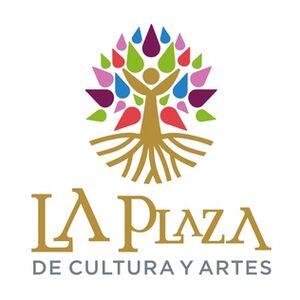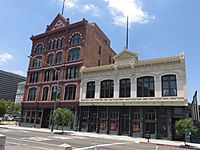LA Plaza de Cultura y Artes facts for kids
 |
|

Plaza House and Vickrey-Brunswig Building.
|
|
| Established | April 2011 |
|---|---|
| Location | 501 North Main Street |
| Public transit access | Union Station |
LA Plaza de Cultura y Artes, often called LA Plaza, is a special museum and cultural center in Los Angeles, California. It celebrates Mexican-American culture and history. LA Plaza opened in April 2011. It is located in two old buildings in downtown Los Angeles.
The center has a museum, a large outdoor area, a stage for performances, and a garden where edible plants grow. It also has a teaching kitchen called LA Cocina de Gloria Molina. This kitchen is a flexible space for events and learning.
Contents
Discovering Los Angeles History
LA Plaza has two main exhibitions that are always there. They are called L.A. Starts Here! and Calle Principal: Mi México en Los Ángeles. There are also other displays that change often. These exhibitions help visitors learn about the past, present, and future of Los Angeles.
L.A. Starts Here! Exhibition
The L.A. Starts Here! exhibition tells the story of Los Angeles in a new way. It aims to show how important Mexicans and Mexican Americans have been to the city.
In October 2024, Los Angeles County Supervisor Hilda L. Solis announced a $2 million donation for this exhibition. This money will help expand and update it. The updates are expected to take three years and cost $5 million in total.
The new exhibition will include stories from Central and South America. It will also share the history of Indigenous communities. The project will make it easier to find information and research. It will also use new interactive technology to make the experience more fun for visitors.
Calle Principal: Mi México en Los Ángeles
Calle Principal: Mi México en Los Ángeles is another important exhibition. It looks like a street from the 1920s. This display was created by Tali Krakowsky, an expert in designing experiences.
Programs and Events at LA Plaza
LA Plaza offers many programs that share the history, cultures, and traditions of Mexicans, Mexican Americans, and all Latinos in Los Angeles. These programs include:
- Salsa concerts
- Book talks
- Family days
- Poetry readings
- Dance performances
- Film screenings
- Workshops
- Tours
- Themed markets
- Panel discussions
LA Plaza's public programs celebrate many different voices and identities. This includes Chicano, Afro-Latino, and LGBTQIA+ communities.
Cooking and Culinary Training
LA Cocina de Gloria Molina is a teaching kitchen at LA Plaza. It highlights the history and influence of Mexican and Mexican American food. Here, you can take cooking classes, attend talks, enjoy food tastings, and watch cooking demonstrations.
LA Plaza also has a Culinary Youth Training Program. This program is free and teaches young people aged 16-24 skills for jobs. It is offered in both English and Spanish.
Leadership at LA Plaza
In April 2022, Leticia Rhi Buckley became the Chief Executive Officer of LA Plaza. She is an experienced arts leader in Los Angeles. She took over from John Echeveste, who retired after leading LA Plaza from 2014 to 2022.
Location and Buildings
LA Plaza is located near Olvera Street. This area is part of the El Pueblo de Los Angeles Historic District. It is also next to La Iglesia de Nuestra Señora Reina de los Angeles, which is often called La Placita or Plaza Church.
The museum is housed in two historic buildings from the 1880s. These are some of the oldest buildings in the city. They are the Vickrey-Brunswig Building and the Plaza House (built in 1883).
LA Plaza is owned by Los Angeles County. The county also owns other museums, like the Los Angeles County Museum of Art.
LA Plaza Paseo Walkway
In 2019, LA Plaza reopened the LA Plaza Paseo Walkway. This pathway had been updated and improved. It is a landscaped path that connects the LA Plaza museum to the historic La Placita Church. The walkway goes from Main Street to Spring Street.
The Paseo Walkway now has signs that tell about the city's past. These signs share stories from the first people who lived there, the Gabrielino-Tongva settlers. They also cover the times when Spain, Mexico, and the United States ruled the area.
The walkway helps people walk easily between Union Station and the new LA Plaza Village residential area.
Outdoor Art on the Walkway
The walkway has been used to display large outdoor sculptures. From 2019 to 2023, it featured Transportapueblos, Companion of Migrants. This was one of a series of wooden coyote sculptures by Mexican artist Alfredo Gutierrez. These sculptures shared helpful information and supplies for migrants.
For four years, a section of the Berlin Wall was displayed on the LA Plaza de Cultura y Artes Walkway. In August 2023, this historic piece was moved. It is now at La Plaza de la Amistad in Playas de Tijuana. This new location is near the US-Mexico border wall. The Berlin Wall piece now helps to show the division between Mexico and the United States.
History of LA Plaza
Building the Center
Los Angeles Times newspaper called County Supervisor Gloria Molina "one of the project's earliest supporters." They said she was the person most responsible for making it happen. Part of the money for the center came from Molina's county funds.
The center is built on 2.2 acres of land. It cost $54 million to build. The design was done by Chu+Gooding Architects.
The old Plaza House and Vickrey-Brunswig Building were repaired in December 2009. The LA Plaza de Cultura y Artes Foundation then finished preparing the inside of the buildings. Their offices moved to the fifth floor of the Vickrey-Brunswig Building in October 2010.
In October 2010, human remains were found during digging for an outdoor garden. These remains were from an old cemetery. 118 bodies were removed. However, construction stopped in January 2011. This happened because people were concerned that the remains might be from Native Americans. There were also concerns about how the digging was handled.
How LA Plaza Operates
A large development with 341 apartments and shops helps fund the nonprofit group that runs LA Plaza. This project was approved in 2014. The county agreed to lease the land to the foundation for a very low price. The foundation then subleases it to the developer.
The project includes a walking area facing Spring Street. This area connects to the LA Plaza Paseo. The Paseo then connects to LA Plaza and Union Station. This layout makes it easier for people to walk to Fort Moore and Grand Park. This project has helped improve the area around Union Station and Olvera Street in downtown Los Angeles.

